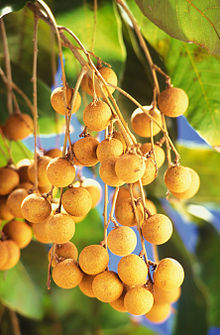| Dimocarpus | |
|---|---|

| |
| Dimocarpus longan fruit | |
| Scientific classification | |
| Kingdom: | Plantae |
| Clade: | Tracheophytes |
| Clade: | Angiosperms |
| Clade: | Eudicots |
| Clade: | Rosids |
| Order: | Sapindales |
| Family: | Sapindaceae |
| Tribe: | Nephelieae |
| Genus: | Dimocarpus Lour. (1790)[1][2] |
| Species[3] | |
|
7; see text | |
| Synonyms[3] | |
|
Pseudonephelium Radlk. (1890) | |
Dimocarpus is a genus of trees or shrubs in the flowering plant family Sapindaceae. It includes 7 species which grow naturally in tropical south and Southeast Asia, Malesia, Papuasia, and Australasia, including Sri Lanka, India, the Philippines, southern China, Taiwan, Myanmar, Cambodia, Vietnam, Malaysia, Indonesia, New Guinea, East Timor, far north-eastern Queensland, Australia.[3]
The fruit is edible, with the longan (D. longan) being grown commercially for fruit production.
The species are large evergreen trees growing to 25–40 m tall, with pinnate leaves. The flowers are individually inconspicuous, produced in large panicles. The fruit is an oval drupe 3–5 cm long containing a single seed surrounded by a translucent crisp, juicy layer of fruit pulp and a thin but hard orange or red skin.
- ^ Cite error: The named reference
Fl.-Malesiana-1994was invoked but never defined (see the help page). - ^ Cite error: The named reference
GRINwas invoked but never defined (see the help page). - ^ a b c Dimocarpus Lour. Plants of the World Online. Retrieved 28 October 2023.